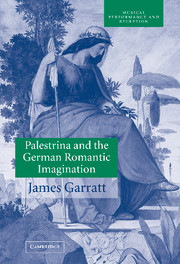Book contents
- Frontmatter
- Contents
- Acknowledgements
- List of abbreviations
- Introduction
- 1 Historicism in nineteenth-century art, aesthetics and culture
- 2 Romanticism and the problem of church music
- 3 The Protestant Palestrina revival
- 4 The Catholic Palestrina revival
- 5 Palestrina in the concert hall
- 6 Interpreting the secondary discourse of nineteenth-century music
- Notes
- Bibliography
- Index
1 - Historicism in nineteenth-century art, aesthetics and culture
Published online by Cambridge University Press: 12 October 2009
- Frontmatter
- Contents
- Acknowledgements
- List of abbreviations
- Introduction
- 1 Historicism in nineteenth-century art, aesthetics and culture
- 2 Romanticism and the problem of church music
- 3 The Protestant Palestrina revival
- 4 The Catholic Palestrina revival
- 5 Palestrina in the concert hall
- 6 Interpreting the secondary discourse of nineteenth-century music
- Notes
- Bibliography
- Index
Summary
ORIGINALITY: CONSENSUS OR CONTROVERSY?
The relation between nineteenth-century compositions and Palestrina's music presents an intractable aesthetic problem: how were composers and their audiences able to reconcile the compositional use of the music of the past with the Romantic imperatives of originality, authenticity and contemporaneity? This discussion approaches the wide range of relationships to Palestrina that are distinguished in the rest of the study in more general terms: here, the implications of such relationships for these three postulates – and thus for aesthetic value – are more important than their specific configurations. But, given the existence of compositions whose totality is defined by their relation to Palestrina's language, it is necessary to explore contemporary aesthetic frameworks which not only justify the partial or transformed use of historical styles in modern art, but also legitimize or condone the literal replication of an earlier style. While the composers discussed in later chapters justified their engagement with the music of the distant past in a variety of ways, one factor is constant: they conceived the problem of compositional historicism not in isolation, but in the context of broader artistic trends. Accordingly, in exploring how art historians, critics and philosophers confronted artistic historicism, the aim is not to construct a spurious Zeitgeist as a background to contemporary musical activities. Rather, it is to seek provisional solutions to this aesthetic problem from a wide range of sources, solutions which will be refined subsequently in relation to specifically musical debates.
- Type
- Chapter
- Information
- Palestrina and the German Romantic ImaginationInterpreting Historicism in Nineteenth-Century Music, pp. 9 - 35Publisher: Cambridge University PressPrint publication year: 2002



